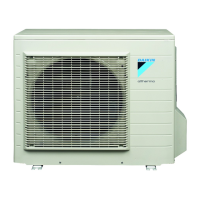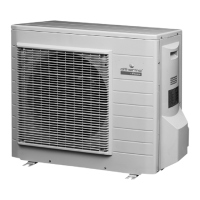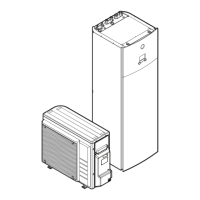ERHQ006~008ADV3(8)
Outdoor unit for air to water heat pump
4PW49002-1A
Installation manual
5
Refrigerant piping work
Pipe handling guidelines
■ Protect the open end of the pipe against dust and moisture.
■ All pipe bends should be as gentle as possible. Use a pipe
bender for bending.
Bending radius should be 30 to 40 mm or larger.
Selection of copper and heat insulation materials
When using commercial copper pipes and fittings, observe the
following:
■ Insulation material: polyethylene foam
Heat transfer rate: 0.041 to 0.052 W/mK (0.035 to 0.045 kcal/
mh°C)
Refrigerant gas pipe's surface temperature reaches 110°C max.
Choose heat insulation materials that will withstand this
temperature.
■ Be sure to insulate both the gas and liquid piping and to provide
insulation dimensions as below.
■ Use separate thermal insulation pipes for gas and liquid
refrigerant pipes.
Purging air and checking gas leakage
When all piping work is completed and the outdoor unit is connected
to the indoor unit, it is necessary to purge the air and check for gas
leakage.
■ If using additional refrigerant, perform air purging from the
refrigerant pipes and indoor unit using a vacuum pump, then
charge additional refrigerant.
■ Use a hexagonal wrench (4 mm) to operate the stop valve rod.
■ All refrigerant pipe joints should be tightened with a torque
wrench at the specified tightening torque. See "Connecting the
refrigerant piping to the outdoor unit" on page 4 for details.
1 Connect the projection side (on which the worm pin is pressed)
of the charging hose coming from the gauge manifold to the gas
stop valve's service port.
2 Fully open the gauge manifold's low-pressure valve (Lo) and
completely close its high-pressure valve (Hi).
The high-pressure valve subsequently requires no operation.
3 Apply vacuum pumping. Check that the compound pressure
gauge reads –0.1 MPa (–760 mm Hg).
4 Close the gauge manifold's low-pressure valve (Lo) and stop the
vacuum pump.
Leave as is for 4-5 minutes and make sure that the coupling
meter needle does not go back.
5 Remove the covers from the liquid stop valve and gas stop
valve.
6 Turn the liquid stop valve's rod 90 degrees counterclockwise
with a hexagonal wrench to open the valve.
Close it after 5 seconds, and check for gas leakage.
Using soapy water, check for gas leakage from the indoor unit's
flare and the outdoor unit's flare and the valve rods.
After the check is complete, wipe all soapy water off.
7 Disconnect the charging hose from the gas stop valve's service
port, then fully open the liquid and gas stop valves.
Do not attempt to turn the valve rod beyond its stop.
8 Tighten the valve lids and service port caps for the liquid and
gas stop valves with a torque wrench at the specified torques.
See "Connecting the refrigerant piping to the outdoor unit" on
page 4 for details.
Pipe size Pipe insulation
Outer
diameter
Thickness
Inner
diameter
Thickness
6.4 mm (1/4") 0.8 mm 8-10 mm ≥10 mm
15.9 mm (5/8") 1.0 mm 16-20 mm ≥13 mm
WARNING
■ Do not mix any substance other than the specified
refrigerant (R410A) into the refrigeration cycle.
■ When refrigerant gas leaks occur, ventilate the room
as soon and as much as possible.
■ R410A, as well as other refrigerants, should always
be recovered and never be released directly into the
environment.
CAUTION
Use a vacuum pump for R410A exclusively. Using the
same vacuum pump for different refrigerants may damage
the vacuum pump or the unit.
5
6
1
2
4
3
1 Gas pipe
2 Inter-unit wiring
3 Liquid pipe
4 Liquid pipe insulation
5 Finishing tape
6 Gas pipe insulation
Pipe length
≤15 m >15 m
Run time ≥10 minutes ≥15 minutes
NOTE
If the meter needle does go back, this may
indicate presence of moisture or leaking from
connecting parts. Repeat steps 2 through 4 after
checking all connecting parts and slightly
loosening and retightening the nuts.
14
10
2
6
5
3
7 8 9
8
1 Pressure meter
2 Gauge manifold
3 Low-pressure valve
(Lo)
4 High-pressure valve
(Hi)
5 Charging hoses
6 Vacuum pump
7 Service port
8 Valve lids
9 Gas stop valve
10 Liquid stop valve

